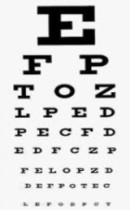 Even if you’ve never been to an eye doctor, you know what the eye chart looks like. It starts with a very large letter at the top, and each progressive line has smaller and smaller letters. The optometrist begins the exam by asking you to cover one eye and read the smallest line that you can see clearly. If you can’t read a certain line further down the chart, you need help (in the form of glasses).
This illustration tells you a lot about the “vision” in your church or ministry or non-profit. When you hear the word “vision,” you probably think of the big picture description of an exciting future. The phrase that I’ve used for years (from my book, Leading Congregational Change) is that vision is a “clear, shared, and compelling description of God’s preferred future.” Having this kind of vision is important. As Bill Hybels says, vision is “the energy that creates action … the fire that ignites the passion of followers” (Courageous Leadership).
But this inspirational vision is like the top line on the eye chart. It’s big and bold, but if you and your followers see nothing beyond this, there’s a problem. Those lower lines – the ones that indicate whether you need corrective lenses – are just as important. In Built to Last, Jim Collins observes, “Organizations often have great intentions and inspiring visions for themselves, but they don’t take the crucial step of translating their intentions into concrete items.” Those crucial steps that need to be taken are the “visionpath.” A well-developed visionpath answers the question, “How will we achieve this vision?”
Here’s an instructive exercise you can do using this concept. Put a vision chart on the wall before your next leadership team meeting. Then ask each person for his or her assessment: start at the top line and ask about the clarity of the overall vision. Then continue to ask as you move down, with the middle lines representing clarity on key priorities and the lower ones representing clarity about the specific steps to be taken. When does the “vision” get blurry?
I hope you’ll discover that everyone can “see” the 20/20 line. But don’t despair if that’s not the case – it simply means that your vision needs some work. It’s far better to get glasses than to wander around bumping into things.
It’s easy to receive my blogs by email. Just sign-up on Feedburner by clicking here.]]>
Even if you’ve never been to an eye doctor, you know what the eye chart looks like. It starts with a very large letter at the top, and each progressive line has smaller and smaller letters. The optometrist begins the exam by asking you to cover one eye and read the smallest line that you can see clearly. If you can’t read a certain line further down the chart, you need help (in the form of glasses).
This illustration tells you a lot about the “vision” in your church or ministry or non-profit. When you hear the word “vision,” you probably think of the big picture description of an exciting future. The phrase that I’ve used for years (from my book, Leading Congregational Change) is that vision is a “clear, shared, and compelling description of God’s preferred future.” Having this kind of vision is important. As Bill Hybels says, vision is “the energy that creates action … the fire that ignites the passion of followers” (Courageous Leadership).
But this inspirational vision is like the top line on the eye chart. It’s big and bold, but if you and your followers see nothing beyond this, there’s a problem. Those lower lines – the ones that indicate whether you need corrective lenses – are just as important. In Built to Last, Jim Collins observes, “Organizations often have great intentions and inspiring visions for themselves, but they don’t take the crucial step of translating their intentions into concrete items.” Those crucial steps that need to be taken are the “visionpath.” A well-developed visionpath answers the question, “How will we achieve this vision?”
Here’s an instructive exercise you can do using this concept. Put a vision chart on the wall before your next leadership team meeting. Then ask each person for his or her assessment: start at the top line and ask about the clarity of the overall vision. Then continue to ask as you move down, with the middle lines representing clarity on key priorities and the lower ones representing clarity about the specific steps to be taken. When does the “vision” get blurry?
I hope you’ll discover that everyone can “see” the 20/20 line. But don’t despair if that’s not the case – it simply means that your vision needs some work. It’s far better to get glasses than to wander around bumping into things.
It’s easy to receive my blogs by email. Just sign-up on Feedburner by clicking here.]]>



